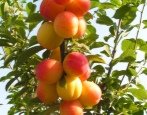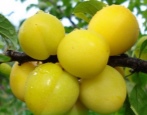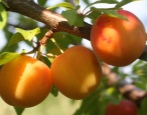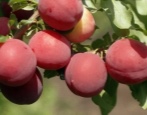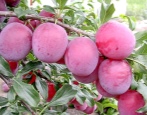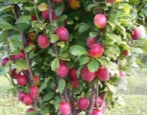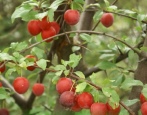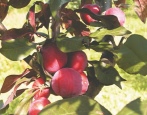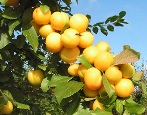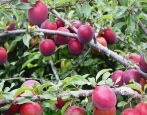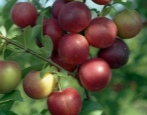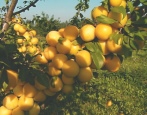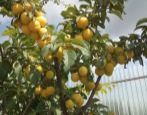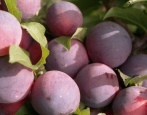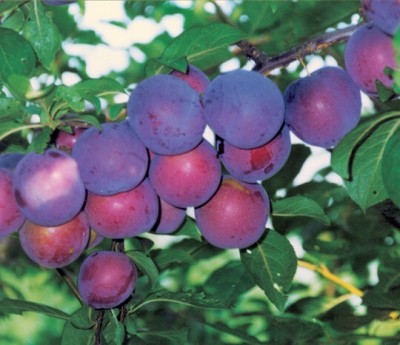
- Growth type: medium-sized
- Ripening period: early maturing
- Self-fertility: self-fertile
- Fruit size: average
- Yield: high
- Transportability: excellent
- Fruit weight, g: 25–30
- Fruit shape: oval
- Fruit color: deep purple
- Pulp (consistency): juicy, crispy
Alycha Monomakh is not included in the State Register of the Russian Federation. But this does not mean that such a plant is futile. You just need to collect accurate information about him, and make the right decision.
Description of the variety
Medium-sized Monomakh is outwardly attractive. Trees grow up to 3 m. The plant is self-fertile, does not need additional pollinating crops.
Fruit characteristics
It is like this:
medium-sized drupes weigh 25-30 g;
oval configuration is typical for them;
the bone and soft part are well separated;
you can save the harvested crop without canning for up to 20-28 days.
Taste qualities
The juicy flesh of Monomakh is distinguished by its expressive crunch. It has a solid purple color. These fruits have a combined sweet and sour taste. The consumer quality of the crop is only getting higher due to the fragrant aroma. It favorably emphasizes the pleasant gastronomic effect of the harvested fruits.
Ripening and fruiting
Varietal norm - the formation of edible drupes at 3 or 4 years of development. Flowers will form mainly in May. Early maturing culture bears fruit mainly in the second half of July.
Yield
The collection can reach 40-60 kg. Such a spread means the undoubted importance of meteorological conditions and the correct choice of the site. But it also implies the relevance of proper care for plantings. What is very useful, the crop is transported without problems. This circumstance is relevant both for commercial cultivation and for summer residents who deliver the grown cherry plum home.
Growing regions
The variety is suitable for the Moscow region. Its cultivation is also allowed in other areas of central Russia. Therefore, it can be recommended for:
Vladimirskaya;
Ryazan;
Kaluga;
Orlovskaya;
Bryansk;
Kursk;
Belgorod;
Saratov;
Samara regions.
Growing and caring
There are no special requirements for the cultivation of cherry-plum Monomakh. This process differs little from caring for other varieties. Plots before planting are fertilized with humus or manure. The introduction of lime helps to cope with excess acidity. Even the winter hardiness of modern cherry plum does not allow ignoring the danger of recurrent frosts.
Young shoots with flower buds need to be especially well protected from them. Self-rooted seedlings are much better suited than any other planting material. The land must be pre-drained. Young seedlings are supported with stakes. The planted cherry plum is immediately watered using 30-40 liters of water.
The crown is predominantly formed in the manner of a bowl. It is very important to ensure that the plant does not stretch excessively upward. Pruning in spring is carried out with the expectation of stimulating the lateral buds and the uniformity of the appearance of the crown. For cherry plum, feeding with phosphorus and potassium is very important. The first of them is carried out in the spring, as soon as the first signs of vegetation are found.
Weeds must be removed very carefully and diligently. The earth around the holes is also supposed to be systematically loosened. For mulching, use humus, compost or peat.They are mixed with chalk or finely ground dolomite. In late autumn cherry plum should be fed with organic matter.
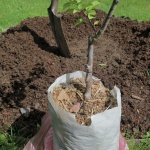
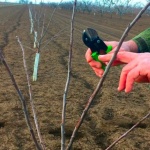
Disease and pest resistance
High resistance to the main diseases of cherry plum is officially declared. But playing it safe is a perfectly reasonable practice for most gardeners. And therefore, it is necessary to resort to preventive treatments when any threats appear.
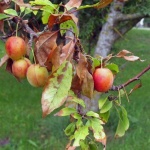
Requirements for soil and climatic conditions
Monomakh endures the winter months well. But only if they correspond to the climatic norm of the main regions where such a crop is grown. The optimal soil is considered to be fertile loam with a neutral acidity level. The presence of soil water is unacceptable near the landing site. Important: the variety is photophilous.


